
Demographic features of the population of Botswana include population density, ethnicity, education level, health of the populace, economic status, religious affiliations and other aspects.

Demographic features of the population of Cambodia include population density, ethnicity, education level, health of the populace, economic status, religious affiliations and other aspects of the population.

The demographic profile of Cameroon is complex for a country of its population. Cameroon comprises an estimated 250 distinct ethnic groups, which may be formed into five large regional-cultural divisions:
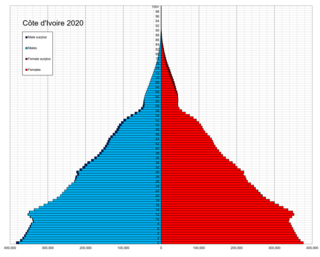
Demographic features of the population of Ivory Coast include population density, ethnicity, education level, health of the populace, economic status, religious affiliations and other aspects of the population.

The population of Indonesia was 270.20 million according to the 2020 national census, an increase from 237.64 million in 2010. Indonesia is the fourth most populous country in the world. Approximately 55% of Indonesia's population resides on Java, which is the most populous island in the world.

The Iraqi people are people originating from the country of Iraq.

Liechtenstein, officially the Principality of Liechtenstein, is a doubly landlocked German-speaking microstate located in the Alps between Austria and Switzerland. It is the sixth smallest nation worldwide. Liechtenstein is a semi-constitutional monarchy headed by the prince of Liechtenstein.
Demographic features of the population of Mayotte include population density, ethnicity, education level, health of the populace, economic status, religious affiliations and other aspects of the population. Mayotte's population density went from 179 persons per square kilometer in 1985 to 251 per square kilometer in 1991. Its capital, Dzaoudzi had a population of 5,865 according to the 1985 census; the island's largest town, Mamoudzou, had 12,026 people.

The demographics of Mozambique describes the condition and overview of Mozambique's peoples. Demographic topics include basic education, health, and population statistics as well as identified racial and religious affiliations.

Demographic features of the population of the Republic of the Congo include population density, ethnicity, education level, health of the populace, economic status, religious affiliations and other aspects of the population.

Demographic features of the population of Eswatini include population density, ethnicity, education level, health of the populace, economic status, religious affiliations and other aspects of the population.

Demographic features of the population of Tanzania include population density, ethnicity, education level, health of the populace, economic status, religious affiliations, and other aspects of the population.

Vaduz is the capital of Liechtenstein and also the seat of the national parliament. The city, which is located along the Rhine River, has 5,696 residents. The most prominent landmark of Vaduz is Vaduz Castle, perched atop a steep hill overlooking the city. It is home to the reigning prince of Liechtenstein and the Liechtenstein princely family. The city's distinctive architecture is also displayed in landmarks such as the Cathedral of St. Florin, Government House, City Hall, the National Art Gallery, as well as the National Museum. Although Vaduz is the best-known town in the principality internationally, it is not the largest; neighbouring Schaan has a larger population.
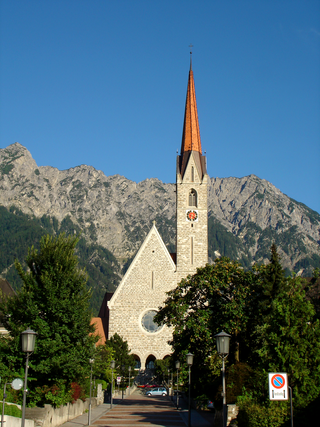
Schaan is the largest municipality of Liechtenstein by population. It is located to the north of Vaduz, the capital, in the central part of the country. As of 2019 it has a population of 6,039, making it the most populous administrative district in Liechtenstein. Representing an important traffic hub and industrial location of the country, Schaan covers an area of 26.8 km2 (10.3 sq mi), including mountains and forest. It is a municipality within the electoral district of Oberland in the Principality of Liechtenstein. Schaan contains four enclaves: Brunnenegg, Gritsch, Guschg, and Plankner Neugrütt.

Triesenberg is a municipality in Liechtenstein with a population of 2,636. Its area of 30 square kilometres (12 sq mi) makes it the largest municipality in Liechtenstein. The center of the municipality rests at an elevation of 884–1,000 metres (2,900–3,281 ft).
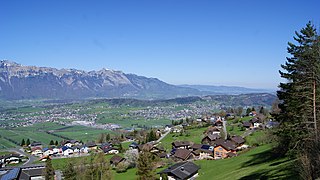
Mauren is a municipality in Liechtenstein that is situated in the north of the country. It has a population of 4,401. The Curta mechanical calculator was produced by Contina AG, in Mauren.
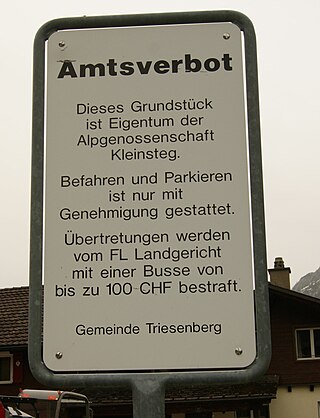
Liechtenstein's official language is German, and the principality is the smallest of the four countries in Europe populated by a majority of German speakers.
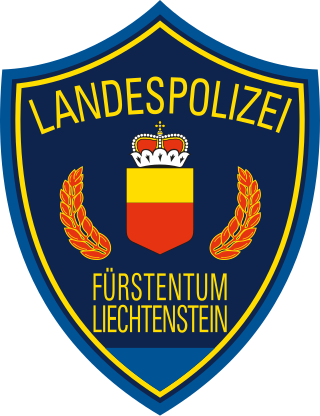
The National Police of the Principality of Liechtenstein, is the national police force of Liechtenstein. It is composed of 125 employees, with 91 officers and 34 staff, who police the 160 km2 (62 sq mi) doubly landlocked alpine state in Western-Central Europe. Bordered by Switzerland to its west, and Austria to its east, Liechtenstein maintains a trilateral treaty which enables close cross-border co-operation between the police services of the three states. Liechtenstein is also a member of Interpol, and a signatory to a variety of other treaties.
Liechtensteiners are a Germanic people native to Liechtenstein linked strictly with Swiss Germans and Swabians. There were approximately 34,000 Liechtensteiners worldwide at the turn of the 21st century.

The demographic features of Brunei include population density, ethnicity, education level, health of the populace, economic status, religious affiliations and other aspects of the population. Like neighbouring countries, Brunei is a Malay-dominated country. Many cultural and linguistic differences make Brunei Malays distinct from the larger Malay populations in nearby Malaysia and Indonesia, even though they are ethnically related and share the Muslim religion.




















